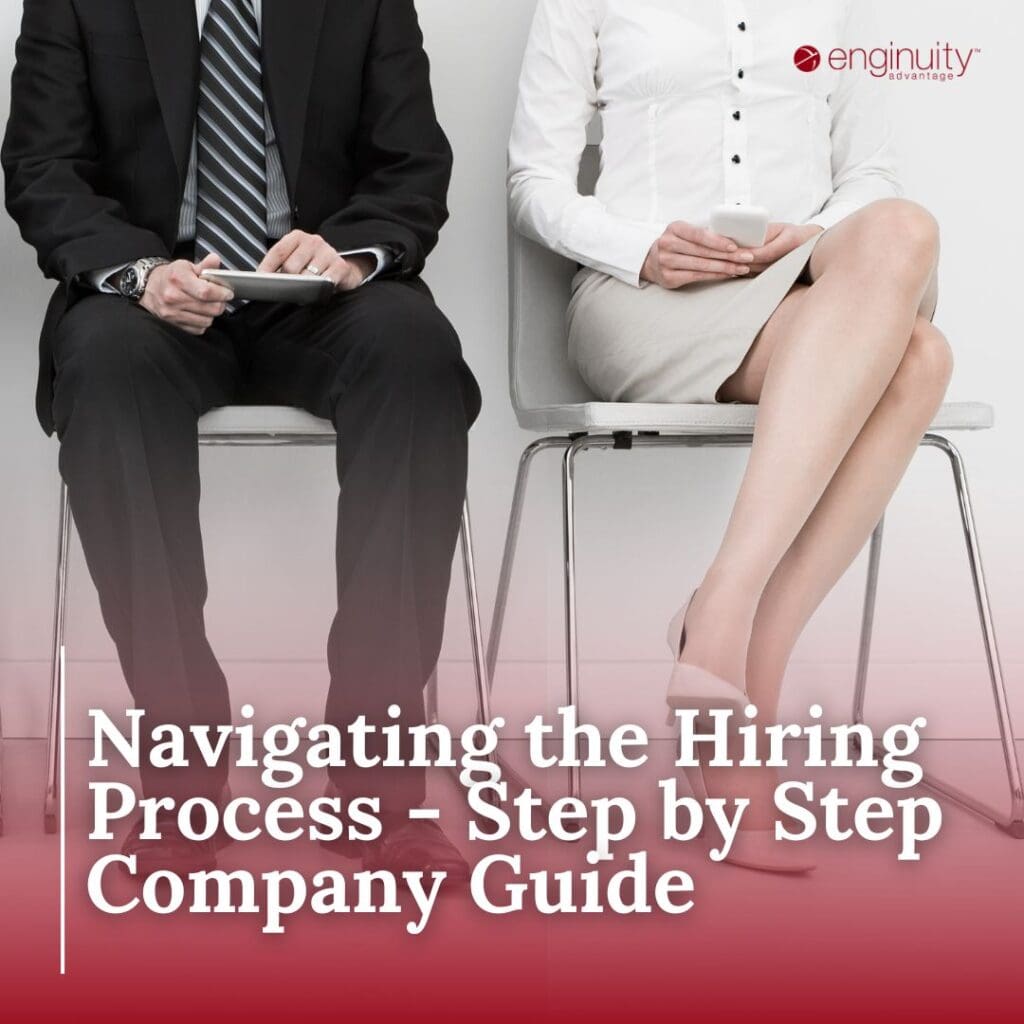Navigating the Hiring Process: Step by Step Company Guide

Whether you’re deep into architecture, construction, aerospace, or navigating the complexities of engineering fields, we can all agree on one thing: hiring is a tricky business. The average cost of hiring a new employee can vary widely by industry and role but often exceeds $4,000 per hire for many companies. This cost includes advertising job openings, interviewing, screening, and onboarding expenses. Like setting up a row of dominoes, one wrong move can send everything crashing down. However, fear not! This guide is here to walk you through the hiring process, making it smoother and more efficient.
Define What You Need
It all starts with knowing exactly what you’re looking for. Sure, it seems straightforward, but this step is where many stumble. It’s not only about skills but finding someone who’s a perfect fit for your company’s ethos. This means diving deep into specifics, like needing someone with geotechnical engineering expertise for your next sustainable construction project or an architect with a flair for green buildings. Here’s the breakdown:
- Understand the Role: Start by identifying the core responsibilities and projects the role will entail.
- Skills Checklist: Separate must-have skills from the nice-to-haves.
- Cultural Fit: Reflect on the personality traits that would flourish within your company’s environment.
- Anticipate Future Needs: Consider how the role might evolve and what skills will be valuable as your company grows.
- Team Input: Engage with team members who will interact with the new hire regularly.
- Craft a Clear Job Description: Sum up everything into a job description that’s both detailed and enticing.
Spread the Word
Now, it’s time to let the world know you’re hiring. Traditional job postings work, but embracing digital platforms can significantly boost your reach, especially among younger professionals.
- Industry-Specific Job Boards: Post on platforms catering directly to your field.
- Professional Networks: Leverage networks like LinkedIn to share your job postings and engage with industry groups.
- Industry Events: Attend conferences and job fairs to connect with potential candidates.
- Educational Partnerships: Collaborate with colleges and universities that offer relevant programs.
- Social Media Strategy: Utilize platforms beyond LinkedIn to share engaging content about your company and open positions.
- Employee Referrals: Encourage your employees to refer professionals from their network.
- Recruiting Firms: Consider partnering with firms like Enginuity Advantage, which specialize in finding top talent in your industry.
- Optimize Your Website: Make sure your careers page is up to date, easily navigable, and SEO-optimized. 60% of job applicants have quit an application process midway because of its length and complexity.
Screen Like a Pro
With applications in hand, it’s crucial to sift through them effectively. It’s about reading between the lines, identifying not just the right skills but also the right person. The top prospect candidates are off the market in 10 days.
- Set Criteria: Establish clear screening criteria based on the job description.
- Use ATS: Application Tracking Systems can help filter applications more efficiently.
- Resume and Cover Letter Review: Look for specifics that align with the job requirements.
- Pre-Screening Calls: Conduct brief calls to gauge communication skills and cultural fit.
- Skill Assessments: Consider practical tasks or assessments to test technical abilities. 82% of companies use some form of pre-employment test to assess candidates.
- Cultural Fit Check: Evaluate how well a candidate’s values align with your company.
- Communication Skills: Pay close attention to how candidates express their experiences and achievements.
- Online Presence Review: A quick look at a candidate’s professional online presence can provide additional insights.
The Interview Dance
Interviews are your chance to dive deeper, but remember, candidates are evaluating you too. On average, companies lost $14,900 on every bad hire. Make it interactive and insightful. A new position takes an average of 27 days to fill.
Prepare: Know the candidate’s background and have a structured set of questions ready.
- Create a Comfortable Environment: Make candidates feel at ease to get genuine responses.
- Right Questions: Ask competency, behavioral, and situational questions relevant to the role.
- Cultural Fit: Share your company’s values and observe how candidates react.
- Candidate Questions: Allow them to ask questions – it shows their interest and helps them assess if they’re a good fit.
- Next Steps: Clearly outline what comes after the interview, setting expectations for both sides.
References and Background Checks
This step is your safety net, ensuring that your final choice is the right one.
- Consent is Key: Always inform candidates that reference checks and background verifications are part of the process.
- Strategic Reference Checks: Ask pointed questions to get a comprehensive understanding of the candidate.
- Background Checks: Use reputable services and be mindful of how you assess the information gathered.
Make the Offer
You’ve found your ideal candidate – congratulations! Now, it’s time to make them an offer they can’t refuse. If rejected, 94% of professionals want to hear interview feedback.
- Be Comprehensive: Include all details of the compensation package, career growth opportunities, and any additional perks.
- Personal Touch: Personalize the offer communication, referencing specific aspects that made them stand out.
- Be Ready to Negotiate: Approach negotiations with openness and flexibility, but know your limits.
- Decision Time: Give them reasonable time to consider the offer and be ready to answer any questions they may have.
Onboarding
The journey doesn’t end with accepting the offer; onboarding is where the real integration begins. Only about 1-in-10 employees strongly agree their organization does an excellent job of onboarding new employees. It sets the tone for the new hire’s experience and can significantly impact their long-term success and satisfaction.
1. Set the Stage Before Day One:
- Prepare Their Workspace: Whether it’s a physical desk or virtual access, make sure everything is set up and welcoming.
- Inform the Team: Let your team know about the new arrival, encouraging them to extend a warm welcome.
2. Day One and The First Week:
- Warm Welcome: Start with a personal greeting and orientation session to make them feel part of the company right away.
- Introductions: Arrange meet-and-greets with key team members and other departments they’ll be working with.
- Mentor/Buddy System: Assign a mentor or buddy to guide them through their first weeks, answering any questions and facilitating introductions. 33% of new employees want their manager or supervisor to show them the ropes.
3. Training and Development:
- Tailored Training Plan: Develop a training plan that covers the specific skills and knowledge they’ll need for their role.
- Set Goals: Discuss short-term objectives and long-term career goals, showing your investment in their growth.
4. Continuous Support:
- Regular Check-Ins: Schedule frequent meetings to discuss their progress, address concerns, and offer feedback.
- Encourage Feedback: Create an environment where they feel comfortable sharing their thoughts and suggestions.
5. Integration into Company Culture:
- Company Events: Involve them in company events and social gatherings to build relationships and integrate them into the company culture.
- Feedback Loop: Solicit their feedback on the onboarding process and use it to make continuous improvements.
6. Review and Adjust:
- Monitor Progress: Keep an eye on their development and integration, offering support and adjustments as needed.
- Formal Review: Conduct a formal review at the end of the onboarding period to assess their fit and satisfaction.
Effective onboarding is about more than just paperwork and procedures; it’s about fostering a sense of belonging, preparing them for their role, and integrating them into the company culture. Enginuity Advantage can help streamline this process, ensuring that your onboarding not only sets up new hires for success but also aligns with your company’s values and long-term goals.
Where Enginuity Advantage Comes In
Navigating the hiring process from start to finish is no small feat, especially when you’re looking for the perfect fit in specialized fields. By carefully defining the role, spreading the word effectively, screening candidates thoroughly, conducting meaningful interviews, performing diligent checks, making a compelling offer, and executing a thoughtful onboarding process, you set the foundation for a successful hire. Remember, Enginuity Advantage is here to guide you through each step, ensuring you not only attract but retain the top talent your company needs to thrive. Ready to enhance your hiring process? Reach out to Enginuity Advantage today and take the first step towards building your dream team.
Unlock Dream Careers & Elite Talent: Just One Click Away!


